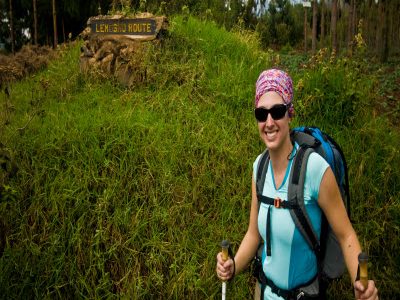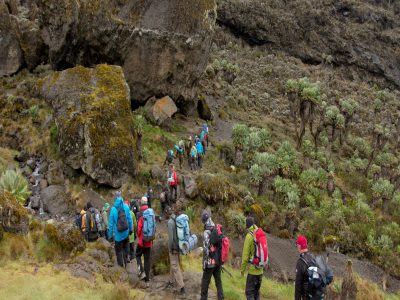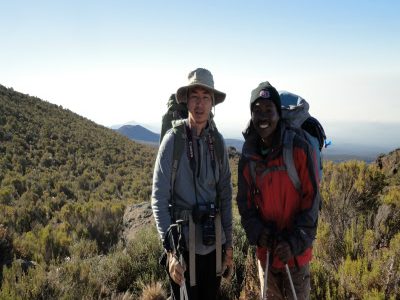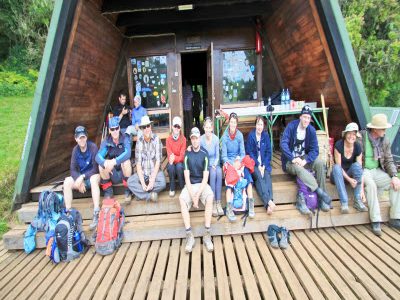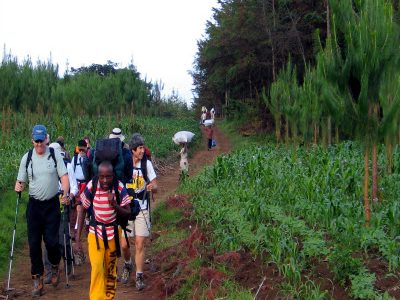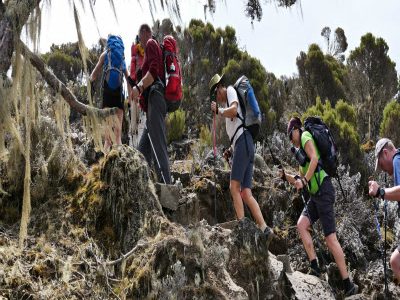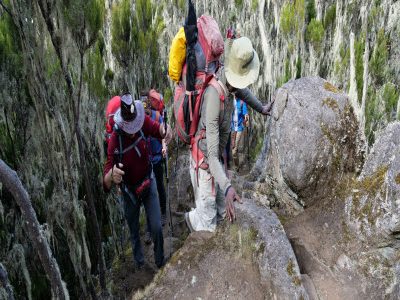Mount Kilimanjaro
Kilimanjaro National Park is the second most visited park in Tanzania. Kilimanjaro National Park features the well-known Mount Kilimanjaro, with both challenging and easy climbing routes. The mountain is one of the seven summits (the highest peaks on each of the seven continents) and rises 5895 meters or 19,340 feet above sea level, It rises 4877 m above the surrounding plains. The forest surrounding the mountain is teeming with life, including elusive elephant, leopard, buffalo, bushbuck, primates, antelope, and the endangered Abbott’s duiker.
Size:
1,688 km²
Location
Mount Kilimanjaro is located in Tanzania, a country in East Africa.
Getting to:
The Park Headquarters is at Marangu, about 44 Km from Moshi town and 86 Km from Kilimanjaro International Airport (JRO).
Best time to visit:
Clearest and warmest conditions from December to February, but also dry (and colder) from July to September. Remember Mountain climbing can be done through the year.
Why you should Visit Kilimanjaro
At 5895 m, Mount Kilimanjaro is the tallest freestanding mountain in the word, awarding it the appropriate title as the 'Roof of Africa'. "As wide as all the world, great, high and unbelievably white", was the famous writer, Ernest Hemingway's, description.
Now a world heritage site, its outstanding features are its three major volcanic centre Shira in the west, Mawenzi in the East and the snow-capped Kibo in the centre. In addition to the stunning beauty of the mountain, a variety of animals can be found in the park, including the Kilimanjaro tree hyrax, bushbuck, grey and red duiker, cape buffaloes, leopards, colobuses, blue monkeys, and elephants.
CLIMATIC CONDITION
Equatorial to arctic conditions are present on Kilimanjaro. The range begins with the warm, dry plains with average temperature of 30° C, ascends through a wide belt of wet tropical forest, through zones with generally decreasing temperatures and rainfall, to the summit where there is permanent ice and below freezing temperatures. Weather on Kilimanjaro is a direct result of season of the year side and altitude on the mountain. The rainiest period is March to June. The fact that most months of the year have so few rainy days makes it possible to climb in relatively good condition all year around.
The dry season, beginning in late June and through July can be very cold at night, but usually is clear of clouds. August and September are also cool and can have completely clear days, but usually a dripping cloud belt girdles the mountain above the forest and moorland. Even through one can climb throughout the year, January, February and September are the best months, with July, August, November and December also being good.
RESCUE IN KILIMANJARO
The Park has a reliable, equipped rescue team on the Marangu route. Rescue service on alternative routes requires that you contact the park Headquarters. There is large hospital in the Moshi area, the Kilimanjaro Christian Medical Centre (KCMC), which can deals with emergency cases.
EQUIPMENT & GEAR
The following list includes some important/useful items to remember
- Baggage & sleeping
Water proof day pack, for you to carry & large soft-sided duffel bag (70L to 90L),Sleeping bag, Ziploc bags (for cameras, binoculars), & sleeping bag liner.
- Clothing
Windproof & waterproof mountain jacket, long sleeved shirts, T-shirts, Thermal long sleeved top, Thick long-johns/thick tights, Warm sweaters of fleeces, Walking trousers (lightweight cargo trousers), waterproof walking trousers, Thin outer rain jacket, Underwear, Thick hiking socks (wool), proper hiking boots (waterproof), Trainers (for wearing around the camp in the evenings), Pair of warm gloves, Balaclava, Gaiters, Sunhat (cap or wide brimmed), & Warm gloves.
- Others
Water bottles, Gatorade, purification tablets, sunglasses, headlamp, Camera, Batteries, watch, notebook, pocket knife, electricity adapter, playing cards, games, books, football, chocolate or pens for village children, business cards, Ear plugs, mobile phone (there is some signal reception available on most parts of the mountain).
- Documents
Passport, Yellow fever certificate, Tanzania tourist visa, Medical Insurance, Airline tickets, Cash, & Credit cards.
- First Aid
Own prescribed medication, malaria tablets, anti nausea tablets, ant-acid, throat lozenges, pain killers, sun protection cream, anti-diarrhea tablets, blister pads, water purification tablets, rehydration packets, plaster/bandages, lip salve/balm (with UV protection), antiseptic cream, small scissors & other medicine / first aid contents.
- Personal Hygiene
Deodorant, Soap, Vaseline, Hairbrush, Toothbrush +toothpaste, Towels, sanitary products, wet wipes & tissue packets, Toilet paper
ALTITUDE
As you ascend the oxygen in the air decreases. Low oxygen in the blood cause shortness of breath during exertion, increased ventilation and heart beats. Thinking may be slowed and co-ordination difficult. You can acclimatize or adapt to the altitude by ascending slowly and pacing yourself, avoiding exertion and breathing regularly and deeply.
ZONE IN MT. KILIMANJARO
Within each zone there is an association between altitude, rainfall, temperature, plants and animals.
- Lower Slopes
Altitude 800-1800m
Rainfall: 500 mm/yr on plains to 1800 mm/yr at forest
Around most of the mountain's lower slopes you will see evidence of human use, particularly grazing of livestock and cultivation. This has totally changed the natural vegetation patterns and what used to be scrub, bush and lowland forest is now grassland. The lower slopes of Kilimanjaro receive water that fell as rain in the forest zone, and then percolated through underground channels. Between Marangu village and the Park gate, and around the hotels, are many lovely wild flowers. In this cultivated zone you will not see large wild animals, but many small ones are there. Most notable in this zone are the birds. Birdlife is especially plentiful where cultivated areas and natural forest meet as there and varied food supply and many nesting sites.
- Forest
Altitude: 1800-2800m
Rainfall: 2000 mm/yr on the southern slopes, less than 1000 mm/yr on the western and northern sides.
This is the richest zone on the mountain. A wide band of extremely beautiful montane forest encircles the whole Kilimanjaro and it is worth a visit even if you are not climbing to the peaks. 96% of the water on Kilimanjaro originates in this forest zone. Flowers in the dense forest are not plentiful, but those seen are often striking. There are few orchids and violets. The most noticeable flowers are balsams (impatients) which form thick carpets in damp shady places. Impatiens pseudoviola is pink and scarlet and yellow. Impatiens kilimanjari is common by streams on Kilimanjaro and grows nowhere else in the world. The forest is the home of most of Kilimanjaro's wild animals. However, they are usually very shy and quite. They hide themselves and they are also hidden from your view by thickness of trees and undergrowth or by mist and cloud. Birds are more common than mammals but can still be hard to identify in thick forest vegetation. Fig trees and other fruiting trees attract some of the larger and more noisy forest birds, such as the SILVERY - CHEEKED HORNBILL- a black and white bird with a loud braying call, and HARTLAUB'S TURACO . Insects are abundant in the forest, but you will not notice many unless you look for them. On a sunny day you may see beautiful butterflies along the trail, the larger and most spectacular ones are swallowtails, Papilio rex is black, cream and orange, whilst Papilio hornimanii, is black and turquoise.
- Heath & Moorland
Altitude: 2800-4000m
Rainfall: Around 1000 mm/yr (Ranges from about 1300 mm/yr at the edge of forest to 530 mm/yr at upper limit of this zone.
This lower alpine zone can be divided into two communities: health and moorland. The climate is usually cool and clear except for mist and fog at the forest boundary.
Heath
This part of the zone is characterized by the heather and health-like shrubs. From Mandara Hut you will see the giant heather, Erica arborea. It is a tree with a gnarled trunk that grows up to 10m in the upper forest but will only reach 3m or so higher up on the moorland. Its flowers are small and white, bell - shaped, and usually clustered at the end of short branches. A large distinctive flower that makes its appearance in this zone is the Protea. It looks somewhat like a white globe-artichoke, with its very large flower and stiff leathery leaves. Nowhere is it abundant, but the species you can see at Maundi Crater, and all the way to Horombo Hut is kilimandscharica, the commonest on the mountain.
Another unmistakable flower is the red-hot poker (Kniphofia thomsonii) with large candle-like spike of tubular red, orange or yellow flowers which rise from a clump of leaves (usually hidden in the grass). Also waving in the grass is the beauful red or salmon-pink Gladiolus watsonioides, and the pink flowered iris, Dierama pendulum. As you ascend through the grassland you will cross wet patches where the ground-cover is a dark, stiff-stemmed sedge, most likely Mariscus kerstenii.
Moorland
You will know you are truly in the moorland when you see clusters of giant lobelias and senecios. These plants characterize the higher elevations and are found in valley bottoms and beside streams. The giant senecios have tall stems which act as reservoirs for the water needed for the large, cabbege-like rosette of leaves. There are two gaint senecios in the moorland zone, each has adapted in special ways. One found nowhere else is the endemic Senecio kilimanjari which grows into a small tree up to 5 m high. There are also two smaller senecious in the moorland zone: a mat-like herb S. meyeri - johannis and a more shurbby one S. purtschelleri. Both have heads of bright yellow flowers. Bogs are a special habitat in the moorland belt with a different variety of plants. There are some bogs near Horombo Hut that are worth looking at closely - but only from the edge. The plentiful water bogs provide giant senecious with a good supply, so you will see them scattered around in them. Many delicate flowers grow close to the ground. There is lovely blue-flowed gentian (Swertia crassiuscula) with a protective rosette of dense leaves and a short stem. There are not many large mammals and those that do visit the moorland are usually in transit to other areas. There are definite sightings of Elands, common duikers, African hunting dogs, buffalos and elephants. Klipspringers may occur in rocky areas and lions sometimes visit the Shira Plateau. Smaller animal are more abundant, as well as more often encountered. Particulary around Horombo Hut you are likely to see the FOUR-STRIPED GRASS MOUSE (Rhabdomys). Birds are not particularly abundant in the moorland zone, but one of the most commonly seen is the unusually friendly ALPINE CHAT, a small dusky brown bird with white side features in its tail. Also seen is the STREAKY SEED-EATER, a brown streaky sparrow-like bird often around Horombo Hut. You may see two types of buzzard soaring overhead. The AUGUR BUZZARD is a large hawk with rounded wings and reddish tail, and an underside that may be either mostly white or mostly black. You are more likely to meet another scavenger, the WHITE-NECKED RAVEN, which is huge crow, black with a white patch behind the neck, that makes a harsh croaking cry. It is a clever, old bird and is seen around the huts waiting for a handout. Zebra Rock is another local feature of interest. It is about 1½ kms above Horombo Hut, near the end of the moorland zone. It is a low cliff with light and dark vertical bands, which were caused by water seeping down the rock face from above and leaving light encrustations on the dark lava rock.
- Highland Desert
Altitude: 4000-5000 m
Rainfall: Probably around 250 mm/yr
This is the alpine zone where it is 'summer every day, winter every night'. There is intense radiation, high evaporation and huge daily fluctuations in temperature. Nights are below 0 ºC and in the daytime it can be as high as 40ºC in direct sun. Water is scarce and there is little soil retain any moisture. A major problems for plants in this high desert is a phenomenon called 'solifluction'. This occurs when the ground freezes, soil-water expands and moves the soil around so plants have to cope with no only freezing but also being uprooted by soil movements.
Flowering plants have a harder struggle to survive here; they have roots to protect and stabilize, and vulnerable leaves, steams and flowers. The commonest one are the woody-stemmed, tough everlastings and the wiry-leaved tussock grasses. In a few places where there is more moisture and shelter, you can still find Senecio telekii, S.meyeri-johannis, S.purtschelleri and the delicate white-petalled Arabis alpina. This little plant is also found in other parts of the world - in Lapland, the Alps and other East African mountains. The large animals that have been seen here, such as elands, leopards, several or African hunting dogs are only passersby although interestingly eland tracks can common be seen on the Saddle. Few birds can cope with the thin air and the strong shifting winds of these altitudes. Ravens and large birds of prey may forage here during the day, but do not live here. The insect residents of the highland desert are almost all small and sedentary. Most have short wings or no wings at all, and keep concealed in tussocks and under rocks to avoid being blown away by the strong winds. There are numerous spiders who feed on the wind-blown and ground-dwelling insects. The highlands desert does not offer much in the way of wildlife, but its views are spectacular. You are close to the two great peaks and can study their features, especially Kibo's glacier and Mawenzi's dykes. The most characteristics feature of the highland desert is the Saddle, technically the area connecting the two peaks.
- Summit
Altitude: Above 5000 m
Rainfall: Probably less than 100 mm/yr. The precipitation is usually not rain, but snow. This area is characterized by arctic conditions - freezing cold at night and burning sun during the day. A few lichens live here but grow slowy at not more than 1 mm/yr, so the red and grey ones you see are probably very old. The highest recorded flowering plants is Helichtysum newii at 5670 m near the eastern fumarole in Kibo's crater. Its woody stem, small leathery leaves and pale while flowers are compact at this altitude. The 'Great Northern Glacier' covers the northern summit of Kilimanjaro. It is a series of terraces, the edges of each fluted into pillars and buttresses. Some of the ice cliffs are 30 m high, the glassy ice contrasting with coarse dark shale. This glacier is all that remains of the glacial ice sheets that once filled the crater. The ice is retreating as a result of being melted by the equatorial sun and a lack of snowfall in the rainy seasons, coupled with warming up of the earth's surface over the past 200 years.
- Special Medical Precautions
Mountain sickness
Above 3000 m some people begin to experience mountain sickness which is caused by the body being unable to acclimatize to the altitude. The best way to prevent this is to ascend slowly, taking care to eat and drink properly. The symptoms include headache, nausea, fatigue, sleeplessness, swelling of hands and feet. Above 4000 m most people have some of these symptoms. If food and fluid intake has been adequate and yet symptoms persist and are severe, the person should descend immediately.
High Altitude Disease
These disease are related to decreased breathing ability while sleeping at high altitude. The remedy is to descend immediately and seek medical attention. The way to prevent high altitude disease, such as those described below, is to allow time for the body to acclimatize by ascending slowly.
Pulmonary Oedema - symptoms include shortness of breath, even at rest, gurgling sound from the chest, a cough and sometime spitting up blood - tinged sputum.
Cerebral Oedema - symptoms include severe headache, lack of co-ordination, and hallucinations that the patient does not acknowledge.
Hypothermia
This often comes on very quickly and is caused by a lowering of the body's internal temperature, usually from becoming wet and thoroughly cold. Cold hands and feet are not indicative of hypothermia. Symptoms include shivering, that will cease as the hyperthermia becomes worse, as well as mental and emotional dulling. The best treatment is to get the person into warm clothes and into a sleeping bag out of the wind and damp. If a personal has severe hyperthermia and is comatose, he must have medical attention immediately and the rescue team should be summoned. Be careful with quick warming or other attempts to weaken the patient as this can cause the cold blood from extremities to return to the body's core resulting in irregular heartbeats and other complications.
KILIMANJARO MENU
Appetites are usually good until about 4000 m, after that food must be especially appealing because few people feel like eating. Light food especially carbohydrates like bread, cereals and rice are recommended. They appear to reduce symptoms of mountain sickness, increase oxygen in the blood as well as provide the body with the 4000 calories per day needed. Citrus fruits and banana are good to eat as they reduce the alkaline condition of the blood caused by the climb. Nuts, fruits and sweets are useful. Avoid fats, rich foods, alcohol and tobacco. Everyone should drink 4-5 liters of fluid each day. Water is best, but fruits & juices are good supplement. Control sweating by wearing removable clothing and pacing yourself.
MOUNTAIN KILIMANJARO ROUTES
The following descriptions of routes on Kilimanjaro include information about directions, accommodation, water availability and some major features as well as maps showing the position of trails and huts. More details about scenic features can be found in the sections describing the zones on the mountain.
Kilimanjaro National Park is one of the world's most accessible high summits, a beacon for visitors from around the world. Most climbers reach the crater rim with little more than a walking stick, proper clothing and determination. And those who reach Uhuru Point, the actual summit, or Gilman's Point on the lip of the crater, will have earned their climbing certificates
| Languages spoken | Swahili |
|---|---|
| Currency used | Tanzanian Shilling |
| Area (km2) | 3885 |
| Country name | Tanzania |


